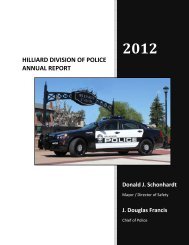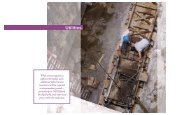The City of Hilliard Sustainability Plan
The City of Hilliard Sustainability Plan
The City of Hilliard Sustainability Plan
Create successful ePaper yourself
Turn your PDF publications into a flip-book with our unique Google optimized e-Paper software.
ECON. EXECUTIVELAND USE DEV.SOCIAL SUMMARY& URBAN EQ.ECOLOGY72<strong>Hilliard</strong> <strong>Sustainability</strong> <strong>Plan</strong>(see Creekside sidebar 3.8), Grandview Heights, and Bexley (see Images3.5 and 3.6) have a number <strong>of</strong> multi-story, mixed-use projectslocated within their major commercial districts and Dublin hasplans for an extensive mixed-use district in their Bridge Street Corridor.One site which can act as a starting point for the <strong>City</strong> to create amixed-use project is the 4.95 acre industrial site within the Old <strong>Hilliard</strong>district. This site has also been identified by <strong>City</strong> <strong>of</strong>ficials as be-» Map 3.9. Potential Old <strong>Hilliard</strong> Infill SiteData Source: <strong>City</strong> <strong>of</strong> <strong>Hilliard</strong>, 2011Incentives for Mixed-Use Development—Case Studyin Eugene Oregon<strong>The</strong> planning department in Eugene, Oregon has put together a number<strong>of</strong> best practices for encouraging mixed-use development. 37 While Eugeneis a much larger city than <strong>Hilliard</strong> (roughly 150,000 residents), theseincentives are still highly relevant to creating mixed-use developments in<strong>Hilliard</strong>. 38 <strong>The</strong> <strong>City</strong> <strong>of</strong> Eugene is encouraging mixed-use as one <strong>of</strong> the mostimportant components <strong>of</strong> their strategy for long-term growth managementand community livability. 39 <strong>The</strong>ir recommendations are broken down int<strong>of</strong>inancial incentives and regulatory relieve. 40Financial Incentives: <strong>The</strong> purpose <strong>of</strong> financial incentives is to reducedevelopment costs or increase the overall return on investment. 41» Tax Abatements: Exempt property taxes for the entire developmentfor an incremental change in property tax for a certain period <strong>of</strong> time» Public Investment in Infrastructure: Road improvements, transitservice, bicycle and pedestrian pathways can all provide neededincentives for a project» Land Assembly: Cities can create large, developable tracts <strong>of</strong> landfor developers by purchasing multiple parcels through voluntarynegotiations with owners or through eminent domain; although thatis the option <strong>of</strong> last choice.Regulatory Relief: <strong>The</strong>se incentives can provide the necessary financesthat make development less expensive to build through adjustments in theregulating process. 42» Reduced Fees: Cities can reduce system development charges orwave permit fees in the mixed-use centers» Permit Processes: Assist developers by having “one-stop centers”for permit information and application. <strong>The</strong>se centers can provideexpedited review <strong>of</strong> higher density/ mixed-use developments.» Development Codes: Assure that local codes are flexible andencourage innovate mixed-use development» Design Standards: Provide bonuses that allow more land for buildingdensity which permit the development costs per square foot todecrease. This can be achieved through increased density and heightallowances, or narrower streets.






